| Cattle drives in the United States from Wikipedia
Cattle drives were a major economic activity in the American
west, particularly between the years 1866-1886, when 20 million cattle
were herded from Texas to railheads in Kansas for shipments to stockyards
in Chicago and points east. The long distances covered, the need for periodic
rests by riders and animals, and the establishment of railheads led to
the development of "cow towns" across the American West. Because of extensive
treatment of cattle drives in fiction and film, the cowboy became the worldwide
iconic image of the American. Cattle drives still occur in the American
west and in Australia.
Origins
.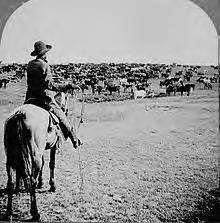
Cattle herd and cowboy, circa 1902 |
Europe had few cattle drives but in the 16th century
the Swiss operated one over the St. Gotthard Pass to the markets in Bellinzona
and Lugano and into Lombardy in northern Italy. The drives had ended by
1700 when sedentary dairy farming proved more profitable.
Long-distance cattle driving was traditional in Mexico,
California and Texas, and horse herds were sometimes similarly driven.
The Spaniards had established the ranching industry in the New World, and
began driving herds northward from Mexico beginning in the 1540s. Throughout
most of the 20th and 19th centuries, small Spanish settlements in Texas
derived much of their revenue from horses and cattle driven into Louisiana,
though such trade was usually illegal. Cattle driving over long distances
also took place in the United States, although infrequently. In 1790 the
boy Davy Crockett helped drive "a large stock of cattle" 400 miles from
Tennessee into Virginia; twenty years later he took a drove of horses from
the Tennessee River into southern North Carolina.[citation needed] Relatively
long-distance herding of hogs was also common. In 1815 Timothy Flint "encountered
a drove of more than 1,000 cattle and swine" being driven from the interior
of Ohio to Philadelphia. The stock in settled areas was gentle, often managed
on foot. |
Movement of cattle
Cattle drives had to strike a balance between speed and
the weight of the cattle. While cattle could be driven as far as 25 miles
(40 km) in a single day, they would lose so much weight that they would
be hard to sell when they reached the end of the trail. Usually they were
taken shorter distances each day, allowed periods to rest and graze both
at midday and at night. On average, a herd could maintain a healthy weight
moving about 15 miles per day. Such a pace meant that it would take as
long as two months to travel from a home ranch to a railhead. The Chisholm
trail, for example, was 1,000 miles (1,600 km) long.
On average, a single herd of cattle on a drive numbered
about 3,000 head. To herd the cattle, a crew of at least 10 cowboys was
needed, with three horses per cowboy. Cowboys worked in shifts to watch
the cattle 24 hours a day, herding them in the proper direction in the
daytime and watching them at night to prevent stampedes and deter theft.
The crew also included a cook, who drove a chuck wagon, usually pulled
by oxen, and a horse wrangler to take charge of the remuda, or spare horses.
The wrangler on a cattle drive was often a very young cowboy or one of
lower social status, but the cook was a particularly well-respected member
of the crew, as not only was he in charge of the food, he also was in charge
of medical supplies and had a working knowledge of practical medicine.
Texas roots
| Texans established trail driving as a regular occupation.
Before Texas broke away from Mexico in 1836, there was a "Beef Trail" to
New Orleans. In the 1840s the Texans extended their markets northward into
Missouri. The towns of Sedalia, Baxter Springs, Springfield, and St. Louis
became principal markets. During the 1850s, emigration and freighting from
the Missouri River westward caused a rise in demand for oxen. In 1858,
the firm of Russell, Majors and Waddell utilized about 40,000 oxen. Longhorns
were trained by the thousands for work oxen. Herds of longhorns were driven
to Chicago, and at least one herd was driven all the way to New York.
The gold boom in California in the 1850s created a demand
for beef and provided people with the cash to pay for it. Thus, though
most cattle were obtained locally or from Mexico, very long drives were
attempted. Australians began cattle drives to ports for shipment of beef
to San Francisco and, after freezing methods were developed, all the way
to Britain. In 1853 the Italian aristocrat Leonetto Cipriani undertook
a drive from St. Louis to San Francisco along the California Trail; he
returned to Europe in 1855 with large profits.
During the American Civil War before the Union seized
the Mississippi River in 1863, Texans drove cattle into the Confederacy
for the use of the Confederate Army. In October, 1862 a Union naval patrol
on the southern Mississippi River captured 1,500 head of Longhorns which
had been destined for Confederate military posts in Louisiana. The permanent
loss of the main cattle supply after 1863 was a serious blow to the Confederate
Army. |
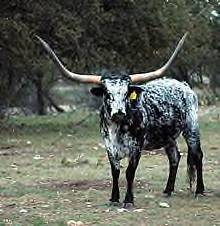
The Texas longhorn was originally driven
overland to the railheads in Kansas; they
were replaced with shorter-horned breeds
after 1900. |
However, in 1865 at the end of the Civil War, Philip Danforth
Armour opened a meat packing plant in Chicago known as Armour and Company,
and with the expansion of the meat packing industry, the demand for beef
increased significantly. By 1866, cattle could be sold to northern markets
for as much as $40 per head, making it potentially profitable for cattle,
particularly from Texas, to be herded long distances to market.
Shawnee Trail (more on this below)
he Shawnee Trail, also known as the Texas Trail, played
a significant role in Texas as early as the 1840s. But by 1853, as 3,000
cattle were trailed through western Missouri, local farmers blocked their
passage and forced the drovers to turn back because the longhorns carried
ticks that carried Texas fever. The Texas cattle were immune to this disease;
but the ticks that they left behind infected the local cattle. By 1855
farmers in western and central Missouri formed vigilance committees, stopped
some of the herds, and killed any Texas cattle that entered their counties,
and a law, effective in December of that year, was passed, banning diseased
cattle from being brought into or through the state. Several drovers took
their herds up through the eastern edge of Kansas; but there, too, they
met opposition from farmers, who induced their territorial legislature
to pass a protective law in 1859. During the Civil War the Shawnee Trail
was virtually unused. After the war, Texas was overflowing with surplus
cattle for which there were almost no local markets. By 1866 an estimated
200,000 to 260,000 surplus cattle were gathered to drive overland to market.
Cattle drive era
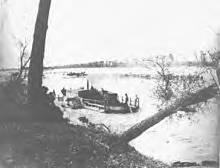
Cattle drive fording the Arkansas River
near Tulsa, Indian Territory in the late
19th Century. The chuck wagon was
carried on a ferry boat |
The first large-scale effort to drive cattle from Texas
to the nearest railhead for shipment to Chicago occurred in 1866, when
many Texas ranchers banded together to drive their cattle to the closest
point that railroad tracks reached, which at that time was Sedalia, Missouri.
However, farmers in eastern Kansas, afraid that transient animals would
trample crops and transmit cattle fever to local cattle, formed groups
that threatened to beat or shoot cattlemen found on their lands. Therefore,
the 1866 drive failed to reach the railroad and the cattle herds were sold
for low prices. By the next year, a cattle shipping facility was built
west of farm country around the railhead at Abilene, Kansas, and became
a center of cattle shipping, loading over 36,000 head of cattle in its
first year. The route from Texas to Abilene became known as the Chisholm
Trail, named for Jesse Chisholm who marked out the route. It ran through
present-day Oklahoma, which then was Indian Territory, but there were relatively
few conflicts with Native Americans, who usually allowed cattle herds to
pass through for a toll of ten cents a head. Later, other trails forked
off to different railheads, including those at Dodge City and Wichita,
Kansas. By 1877, the largest of the cattle-shipping boom towns, Dodge City,
Kansas, shipped out 500,000 head of cattle.
At the close of the war Texas had probably five million
cattle—but no market. Late in 1865 a few |
cowmen tried to find a market,, and in 1866 there were many
drives northward without a definite destination and without much financial
success. Cattle were also driven to the old but limited New Orleans market,
following mostly well-established trails to the wharves of Shreveport and
Jefferson, Texas. In 1868, David Morrill Poor, a former Confederate officer
from San Antonio, drove 1,100 cattle from east of San Angelo into Mexico
over the Chihuahua Trail. This event, the "Great Chihuahua Cattle Drive,"
was the largest cattle drive attempted over that trail up to that time,
but the market was much better in Kansas than in Mexico, so most drives
headed north.
In 1867 Joseph G. McCoy opened a regular market at Abilene,
Kansas. The great cattle trails, moving successively westward, were established
and trail driving boomed. In 1867 the Goodnight-Loving Trail opened up
New Mexico and Colorado to Texas cattle. By the tens of thousands cattle
were soon driven into Arizona. In Texas itself cattle raising expanded
rapidly as American tastes shifted from pork to beef. Caldwell, Dodge City,
Ogallala, Cheyenne, and other towns became famous because of trail-driver
patronage.
Chisholm Trail
The Chisholm Trail was the most important route for cattle
drives leading north from the vicinity of Ft. Worth, Texas,across Indian
Territory (Oklahoma) to the railhead at Abilene. It was about 520 miles
long and generally followed the line of the ninety-eighth meridian, but
never had an exact location, as different drives took somewhat different
paths. With six states enacting laws in the first half of 1867 against
trailing cattle north, Texas cattlemen realized the need for a new trail
that would skirt the farm settlements and thus avoid the trouble over tick
fever. In 1867 a young Illinois livestock dealer, Joseph G. McCoy, built
market facilities at Abilene, Kansas, at the terminus of Chisholm Trail.
The new route to the west of the Shawnee soon began carrying the bulk of
the Texas herds, leaving the earlier trail to dwindle for a few years and
expire.
The typical drive comprised 1,500-2,500 head of cattle.
The typical outfit consisted of a boss, (perhaps the owner), from ten to
fifteen hands, each of whom had a string of from five to ten horses; a
horse wrangler who handled the horses; and a cook, who drove the chuck
wagon. The wagon carried the bedrolls; tents were considered excess luxury.
The men drove and grazed the cattle most of the day, herding them by relays
at night. Ten or twelve miles was considered a good day's drive, as the
cattle had to thrive on the route. They ate grass; the men had bread, meat,
beans with bacon, and coffee. Wages were about $40 a month, paid when the
herd were sold.
The Chisholm Trail decreased in importance after 1871
when, as a result of the westward advance of settlement, Abilene lost its
preeminence as a shipping point for Texas cattle. Dodge City, Kansas became
the chief shipping point for another trail farther west, crossing the Red
River at Red River Station, Texas. The extension of the Atchison, Topeka
and Santa Fe Railway to Caldwell, Kansas, in 1880, however, again made
the Chisholm Trail a most important route for driving Texas cattle to the
North, and it retained this position until the building of additional trunk
lines of railway south into Texas caused rail shipments to take the place
of the former trail driving of Texas cattle north to market.
Cattle towns
| Cattle towns flourished between 1866 and 1890 as railroads
reached towns suitable for gathering and shipping cattle. The first was
Abilene, Kansas. Other towns in Kansas, including Wichita and Dodge City,
succeeded Abilene or shared its patronage by riders fresh off the long
trail. In the 1880s Dodge City boasted of being the "cowboy capital of
the world." Communities in other states, including Ogallala, Nebraska;
Cheyenne, Wyoming; Miles City, Montana; and Medora, North Dakota, served
the trade as well. Amarillo, Fort Worth, and Wichita Falls, all in Texas;
Prescott, Arizona, Greeley, Colorado, and Las Vegas, New Mexico were regionally
important.
The most famous cattle towns like Abilene were railheads,
where the herds were shipped to the Chicago stockyards. Many smaller towns
along the way supported range lands. Many of the cow towns were enlivened
by buffalo hunters, railroad construction gangs, and freighting outfits
during their heyday. Cattle owners made these towns headquarters for buying
and selling.
Cowboys, after months of monotonous work, dull food, and
abstinence of all kinds, were paid off and turned loose. They howled, got
shaved and shorn, bought new clothes and gear. They |
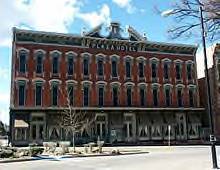
The Plaza hotel in Las Vegas, New Mexico
opened a year after the railroad established
it as a key railhead for the cattle drives. |
drank "white mule" straight. Madames and gambling-hall operators
flourished in towns that were wide open twenty-four hours a day. Violence
and ebullient spirits called forth a kind of "peace officer" that cattle
towns made famous—the town marshal. Wild Bill Hickok and Wyatt Earp were
perhaps the two best-known cattle town marshals. The number of killings
was, however, small by the standards of eastern cities.
End of the open range
Expansion of the cattle industry resulted in the need
for additional open range. Thus many ranchers expanded into the northwest,
where there were still large tracts of unsettled grassland. Texas cattle
were herded north, into the Rocky Mountain west and the Dakotas. In 1866,
Nelson Story used the Bozeman Trail to successfully drive about 1000 head
of longhorn cattle into the Gallatin Valley of Montana. Individual cattle
barons such as Conrad Kohrs built up significant ranches in the northern
Rockies. In 1866, Kohrs purchased a ranch near Deer Lodge,
| Montana from former Canadian fur-trader Johnny Grant.
At its peak, Kohrs owned 50,000 head of cattle, grazing on 10 million acres
(40,000 km²), spread across four states and two Canadian Provinces
and shipping 10,000 head of cattle annually to the Chicago stock yards.Later,
however, continued overgrazing, combined with drought and the exceptionally
severe winter of 1886-87 wiped out much of the open-range cattle business
in Montana and the upper Great Plains. Following these events, ranchers
began to use barbed wire to enclose their ranches and protect their own
grazing lands from intrusions by others' animals.
In the 1890s, herds were still occasionally driven from
the Panhandle of Texas to Montana. However, railroads had expanded to cover
most of the nation, and meat packing plants were built closer to major
ranching areas, making long cattle drives to the railheads unnecessary.
Hence, the age of the open range was gone and the era of large cattle drives
were over. |
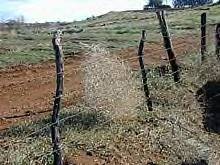 |
Modern cattle drives
Smaller cattle drives continued at least into the 1940s,
as ranchers, prior to the development of the modern cattle truck, still
needed to herd cattle to local railheads for transport to stockyards and
packing plants. Today, cattle drives are primarily used to round up cattle
within the boundaries of a ranch and to move them from one pasture to another,
a process that generally lasts at most a few days. Because of the significance
of the cattle drive in American history, some working ranches have turned
their seasonal drives into tourist events, inviting guests in a manner
akin to a guest ranch to participate in moving the cattle from one feeding
ground to the next. While horses are still used in many places, particularly
where there is rough or mountainous terrain, the all-terrain vehicle is
also used. When cattle are required to move longer distances, they are
shipped via truck.
Events intended to promote the western lifestyle may incorporate
cattle drives. For example the Great Montana Centennial Cattle Drive of
1989 celebrated the state of Montana's centennial and raised money for
a college scholarship fund as 2,400 people (including some working cowboys),
200 wagons and 2,800 cattle traveled 50 miles in six days from Roundup
to Billings along a major highway. Similar drives have been sponsored since
that time.
Cowboy culture
| The cowboy's distinctive working gear, most of it derived
from the Mexican vaquero, captured the public image. High-crowned cowboy
hat, high-heeled boots, leather chaps, pistol, lariat, and spurs were functional
and necessary in the field, and fascinating on the movie screen. Increasingly
the public identified the cowboy with courage and devotion to duty, for
he tended cattle wherever he had to go, whether in bogs of quicksand; swift,
flooding rivers; or seemingly inaccessible brush. He rode with lightning
and blizzard, ate hot summer sand, and was burned by the sun. Theodore
Roosevelt conceptualized the herder as a stage of civilization distinct
from the sedentary farmer—a classic theme well expressed in the 1944 Broadway
hit "Oklahoma!"—Roosevelt argued that the manhood typified by the cowboy—and
outdoor activity and sports generally—was essential if American men were
to avoid the softness and rot produced by an easy life in the city. The
cow towns along the trail were notorious for providing liquor to the cowboys;
they usually were not allowed to drink on the trail itself.
Image and memory
During three decades it had moved over ten million cattle
and one million range horses, stamped the entire West with its character,
given economic and personality prestige to Texas, made the longhorn historic,
glorified the cowboy over the globe, and endowed America with its most
romantic tradition relating to any occupation.
The best known writers of the era include Theodore Roosevelt,
who spent much of his inheritance ranching in the Dakotas in the 1880s,
Will Rogers, the leading humorist of the 1920s, and Indiana-born Andy Adams
(1859–1935), who spent the 1880s and 1890s in the cattle industry and mining
in the Great Plains and Southwest. When an 1898 play's portrayal of Texans
outraged Adams, he started writing plays, short stories, and novels drawn
from his own experiences. His The Log of a Cowboy (1903) became a classic
novel about the cattle business, especially the cattle drive. It described
a fictional drive of the Circle Dot herd from Texas to Montana in 1882,
and became a leading source on cowboy life; historians retraced his path
in the 1960s, confirming his basic accuracy. His writing is acclaimed and
criticized for both its fidelity to truth and lack of literary qualities.
Cattle drives on television and film
Cattle drives were a major plot element of many Hollywood
films and television shows, particularly during the era when westerns were
popular. One of the most famous movies is Red River (1948) directed by
Howard Hawks, and starring John Wayne and Montgomery Clift. Like many such
films, Red River tended to exaggerate the dangers and disasters of cattle
driving. More recently, the movie City Slickers (1990) was about a guest
ranch-based cattle drive. The long running TV show Rawhide (1959–1965),
starring Eric Fleming and Clint Eastwood, dealt with drovers taking 3000
head along the Sedalia trail from San Antonio, Texas to the railhead at
Sedalia. The 1980s miniseries Lonesome Dove centered on a cattle drive
from South Texas to Montana. |
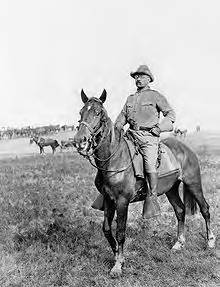
Theodore Roosevelt
(shown on horseback,1898)
helped popularize the image of the
American cowboy through his writings.
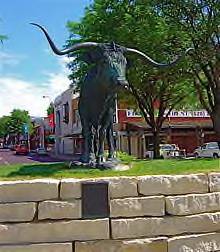
A monument to the cattle drive era in
Dodge City, Kansas
|
|
| Texas Road From Wikipedia
The Texas Road, also known as the Shawnee Trail, was a
major trade and emigrant route across Texas, Indian Territory Oklahoma,
Kansas and Missouri. It was the first Texas North South Cattle Drive. Established
during the Mexican War by emigrants rushing to Texas, it remained an important
route across Indian Territory until Oklahoma statehood.
The Shawnee Trail Route
The Shawnee Trail played a significant role in Texas and
beyond in the early 1800's. A group of interested cities from Waco to Pottsboro,
and cities in between hope you enjoy some of the sights and sounds that
play homage to the Shawnee Trail in each of our cities.
"Of the principal routes by which Texas longhorn cattle
were taken afoot to railheads to the north, the earliest and easternmost
was the Shawnee Trail. Used before and just after the Civil War, the Shawnee
Trail gathered cattle from east and west of its main stem, which passed
through Austin, Waco, and Dallas. It crossed the Red River at Rock Bluff,
near Preston, and led north along the eastern edge of what became Oklahoma,
a route later followed closely by the Missouri-Kansas-Texas Railroad. The
drovers took over a trail long used by Indians in hunting and raiding and
by southbound settlers from the Midwest; the latter called it the Texas
Road. North of Fort Gibson the cattle route split into terminal branches
that ended in such Missouri points as St. Louis, Sedalia, Independence,
Westport, and Kansas City, and in Baxter Springs and other towns in eastern
Kansas. Early drovers referred to their route as the cattle trail, the
Sedalia Trail, the Kansas Trail, or simply the trail. Why some began calling
it the Shawnee Trail is uncertain, but the name may have been suggested
by a Shawnee village on the Texas side of the Red River just below the
trail crossing or by the Shawnee Hills, which the route skirted on the
eastern side before crossing the Canadian River."
Texas herds were taken up the Shawnee Trail as early as
the 1840s, and use of the route gradually increased. But by 1853 trouble
had begun to plague some of the drovers. In June of that year, as 3,000
cattle were trailed through western Missouri, local farmers blocked their
passage and forced the drovers to turn back. This opposition arose from
the fact that the longhorns carried ticks that bore a serious disease that
the farmers called Texas fever. The Texas cattle were immune to this disease;
but the ticks that they left on their bedgrounds infected the local cattle,
causing many to die and making others unfit for marketing. Some herds avoided
the blockades, and the antagonism became stronger and more effective. In
1855 angry farmers in western and central Missouri formed vigilance committees,
stopped some of the herds, and killed any Texas cattle that entered their
counties. Missouri stockmen in several county seats called on their legislature
for action. The outcome was a law, effective in December of that year,
which banned diseased cattle from being brought into or through the state.
This law failed of its purpose since the longhorns were not themselves
diseased. But farmers formed armed bands that turned back some herds, though
others managed to get through. Several drovers took their herds up through
the eastern edge of Kansas; but there, too, they met opposition from farmers,
who induced their territorial legislature to pass a protective law in 1859.
During the Civil War the Shawnee Trail was virtually unused.
After the war, with Texas overflowing with surplus cattle for which there
were almost no local markets, pressure for trailing became stronger than
ever. In the spring of 1866 an estimated 200,000 to 260,000 longhorns were
pointed north. Although some herds were forced to turn back, others managed
to get through, while still others were delayed or diverted around the
hostile farm settlements. James M. Daugherty, a Texas youth of sixteen,
was one who felt the sting of the vigilantes. Trailing north his herd of
500 steers, he was attacked in southeastern Kansas by a band of Jayhawkers
dressed as hunters. The mobsters stampeded the herd and killed one of the
trail hands; (some sources say they tied Daugherty to a tree with his own
picket rope, then whipped him with hickory switches.) After being freed
and burying the dead cowboy, Daugherty recovered about 350 of the cattle.
He continued at night in a roundabout way and sold his steers in Fort Scott
at a profit. With six states enacting laws in the first half of 1867 against
trailing, Texas cattlemen realized the need for a new trail that would
skirt the farm settlements and thus avoid the trouble over tick fever.
In 1867 a young Illinois livestock dealer, Joseph G. McCoy, built market
facilities at Abilene, Kansas, at the terminus of Chisholm Trail. The new
route to the west of the Shawnee soon began carrying the bulk of the Texas
herds, leaving the earlier trail to dwindle for a few years and expire.
An early cattle trail, the Shawnee Trail, followed the
route. The path stretched from Baxter Springs, Kansas in the north, across
the Cherokee, Choctaw, and Chickasaw Nations, to Colbert's Ferry, Indian
Territory in the south. Later the Shawnee Trail branched further west.
The first route was then called the East Shawnee Trail and the branch called
the West Shawnee Trail. The western branch particularly remained the main
cattle trail from Texas until the opening of the Chisholm Trail (or Abilene
Trail) following the Civil War.
There were two parts of the trail that set out from Kansas
the eastern trail which followed the Grand River to Fort Gibson, and the
western trail which started in Missouri and passed through Fort Wayne before
joining the other trail continuing to the Red River on the Texas border.
Several stations were set up along the road where travelers could rest
and refresh their horses.
Both sides of the Civil War used the road heavily to move
supplies and troops. Union and Confederate forces met at the Battle of
Honey Springs on the road. The Texas Road eventually became part of U.S.
Route 69.
|